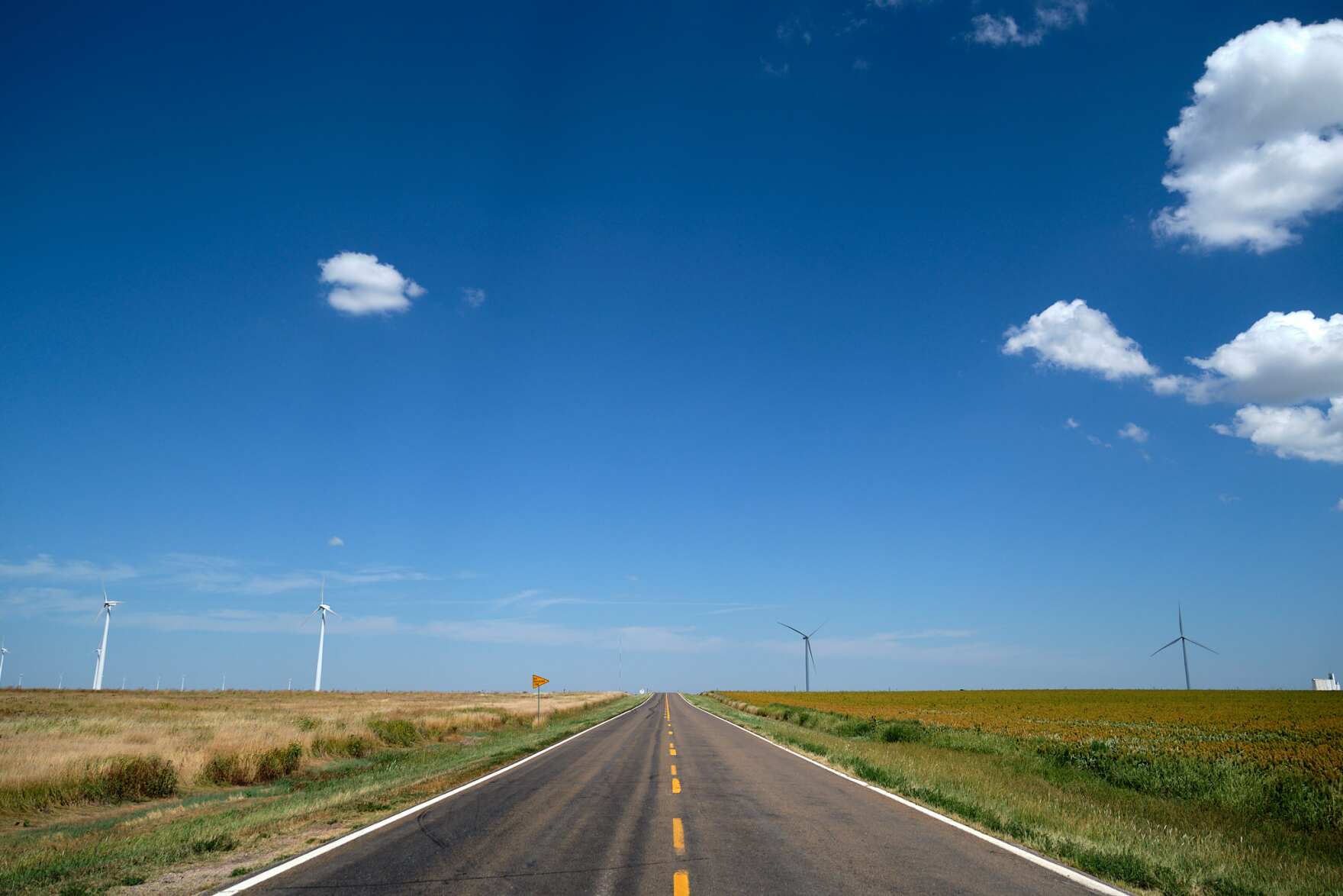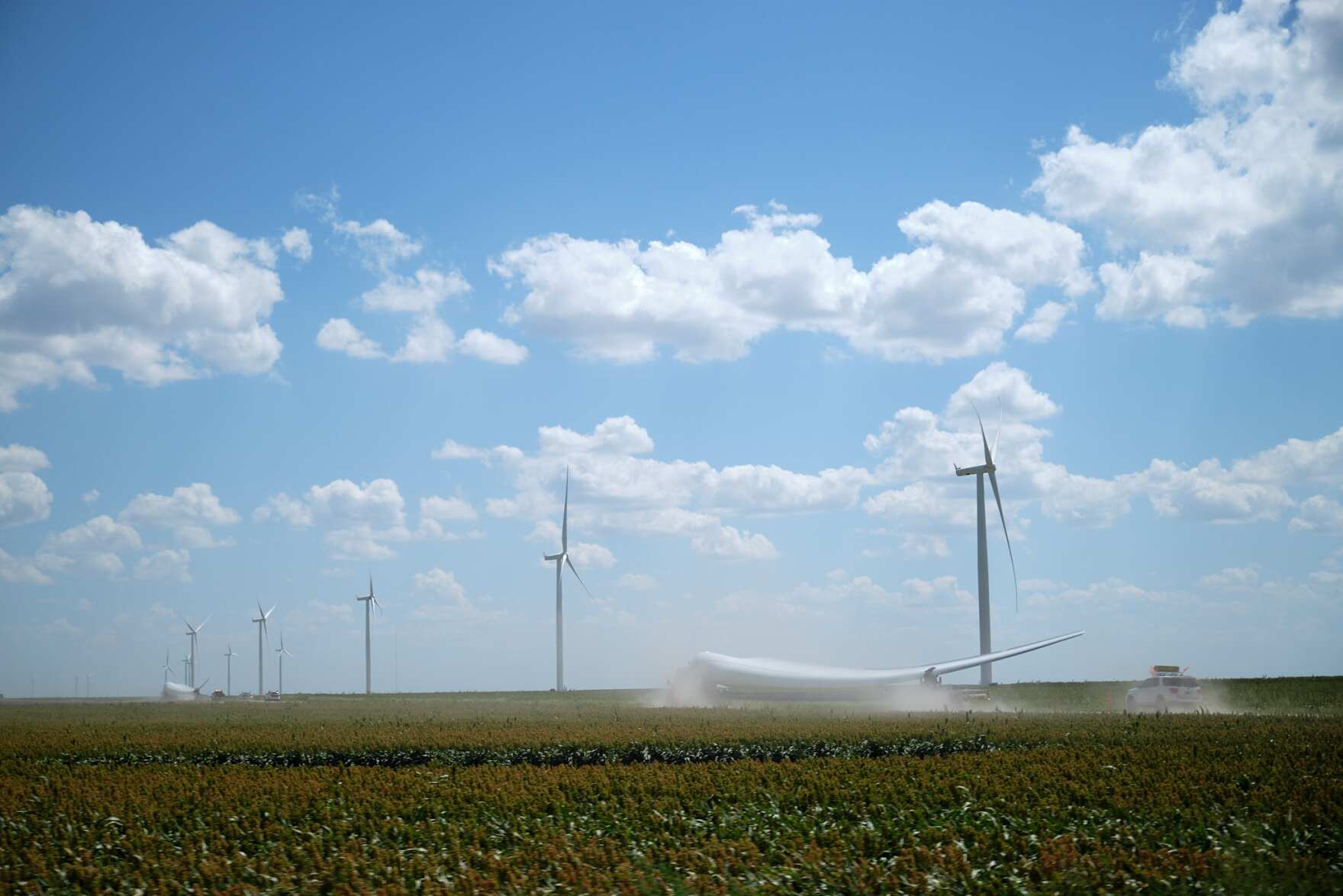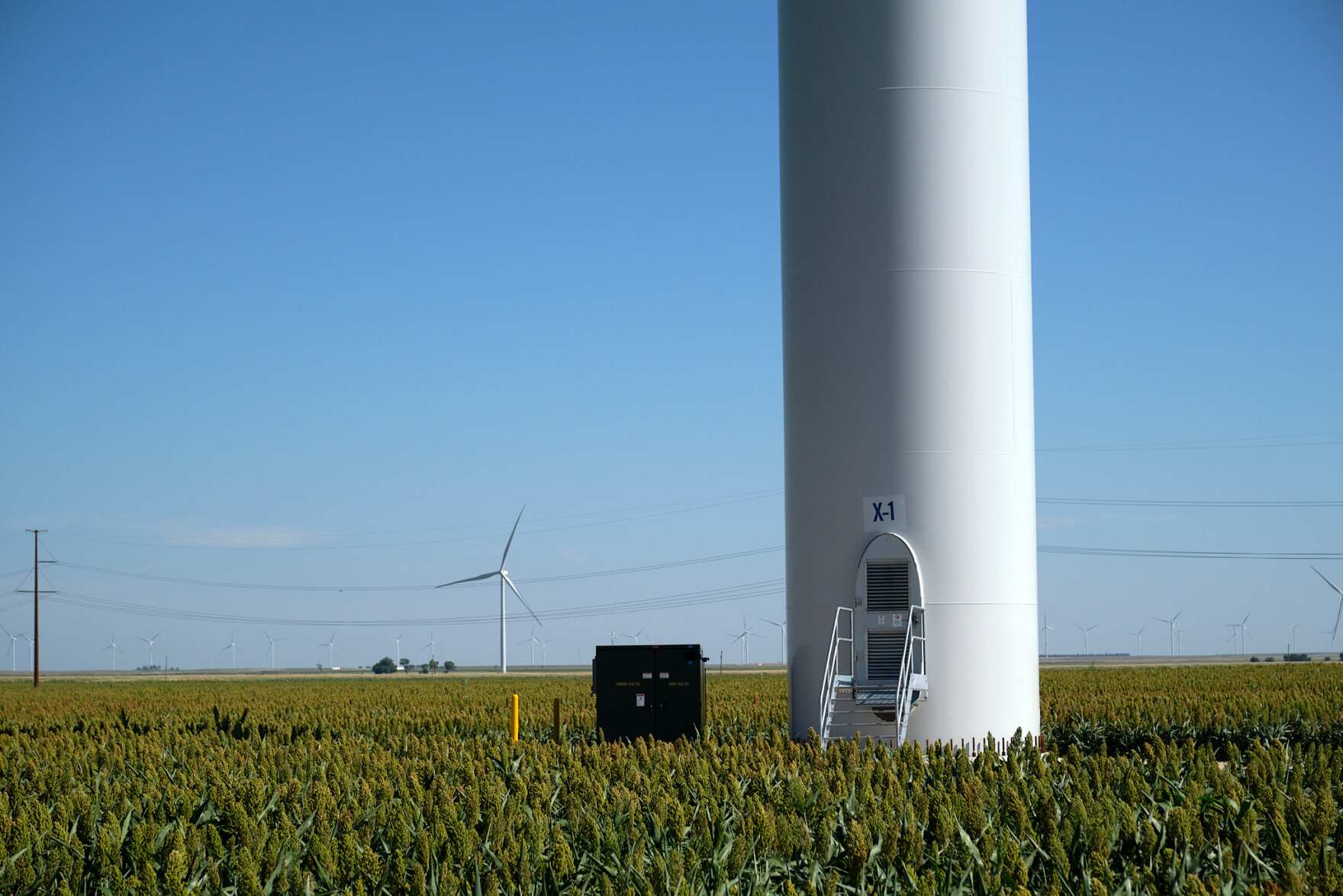What’s Next For Kansas After 20 Years Of Wind Power?
8:06 minutes

 This article is part of The State of Science, a series featuring science stories from public radio stations across the United States. This story features reporting from KMUW Public Radio.
This article is part of The State of Science, a series featuring science stories from public radio stations across the United States. This story features reporting from KMUW Public Radio.
The wind farm business in Kansas has hit its awkward adolescence. It’s still growing 20 years in, but unsure what the near future might hold.
If it wants to get through those tough years and continue to grow, it needs to find more workers, to figure out what to do with the dated-but-not-obsolete turbines erected two decades ago and to sort out a way to carry all that wind-harvesting muscle beyond the state’s borders.
Consider the burly, newest version of wind farming at the Cimarron Bend wind farm south of Dodge City. “We just watch and listen to the towers,” said project supervisor Dewain Pfaff, who’s responsible for keeping about 300 turbines up and running. “If you can hear a noise we want to mitigate those issues as soon as possible.”
Standing at the base of one of the newest turbines on the site, he’s dwarfed by the tower that rises 300 feet into the air. That’s almost as tall as the Kansas State Capitol. Add in the blade when pointing straight up and it’s taller than the tallest building in the state.
That mammoth size is one way wind turbines have changed over the past 20 years. While the turbine is nearly 300 feet tall, the turbines at the very first large-scale wind farm in the state stretched only 200 feet above the ground.
Transporting larger towers and blades is trickier, but inevitable.

Wind turbines are relatively simple devices with only a few moving parts. But like all machines, they still require maintenance and repairs. About 35 people are on site daily at the Cimarron Bend projects. Stand close to one of the turbines and the woosh of the blades traveling as fast as 150 mph at the tip is quite loud. Walk a half-mile away and you can barely hear one.
Inside the giant structures, once the turbines are shut down, technicians can grease bearings, patch blades and inspect for other mechanical or electrical faults. Last year, almost 450 new wind turbines were erected in Kansas. Nearly as many will go up this year.
“It’s not just that the industry needs to hire a lot of new technicians,” said Kit Thompson, chair of the renewable energy program at Cloud County Community College, “they’re offering very, very good pay.” The Bureau of Labor Statistics says the median pay for a wind tech in 2020 was $56,000 a year. Wind technician is also expected to be one of the fastest-growing jobs over the next 10 years.
Part of thinking about the future of the industry is figuring out what to do when turbines start to age. Turbines are typically built to last 20 to 25 years, but that lifespan can be extended by decades through changing out parts and replacing blades. The energy company ENEL recently went through the process, known as repowering, at its wind farm in Ellsworth County.
ENEL’s head of sustainability, Marcus Krembs said about 85% of wind turbine components are fully recyclable. The giant blades, however, are not. Krembs said the company has committed to make sure old blades don’t end up in landfills.
“We’re using a handful of blades from (that project) and partnering with an academic consortium to utilize those blades as transmission poles,” he said.
Wind turbine and blade manufacturers are also working on ways to make the blades easier and cheaper to recycle. Siemens Gamesa just launched what it’s calling the world’s first fully recyclable blade. It will be used on turbines being built off the shore of Germany.
But there’s another major obstacle to continued growth in the wind industry. “There’s one word and it’s transmission,” Krembs said. Transmission cables are the large wires used to transport high-voltage electricity from places where energy is produced, like Kansas, to the population centers to the east and west where it’s needed.

Alan Anderson is an attorney who helps represent renewable energy projects, including the proposed 800-mile-long multi-state transmission project known as the Grain Belt Express. “Similar to corn, beans and wheat, where we export,” he said, “it would be great if we could get the same with our renewable resources, that we can harvest it and get it to the marketplace to the benefit of Kansans.”
The Grain Belt Express has been in the works for more than a decade while it’s sought government approval. When completed, Anderson said, it will be key to unlocking more of Kansas’ renewable potential by expanding the potential list of buyers for the state’s wind energy.
Even with more transmission, he said wind energy growth in Kansas will eventually slow. Especially as solar and battery storage becomes more affordable. But he said as long as the wind still blows in Kansas, there will be plenty of opportunities left to take advantage of one of the state’s most desired natural resources.
Brian Grimmett reports on the environment, energy and natural resources for KMUW in Wichita and the Kansas News Service. You can follow him on Twitter @briangrimmett or email him at grimmett (at) kmuw (dot) org. The Kansas News Service is a collaboration of KCUR, Kansas Public Radio, KMUW and High Plains Public Radio focused on health, the social determinants of health and their connection to public policy.
Invest in quality science journalism by making a donation to Science Friday.
IRA FLATOW: This is Science Friday. I’m Ira Flatow. And now it’s time to check in on the state of science.
– This is Kate– for WWNO– St Louis Public Radio– Iowa Public Radio news–
IRA FLATOW: Local science stories of national significance. You know that famous scene in The Wizard of Oz, where a giant windstorm in Kansas sweeps up Dorothy’s house? Well they are harnessing that wind with wind turbines at an amazing pace. The state just hit a major milestone, 20 years since the first big wind farm went online in a small town called Montezuma. Kansas is now the fourth biggest generator of wind power in the country. Wind energy has changed both the landscape and economy of the region. So joining me today to tell us more about that is my guest Brian Grimmett, energy and environment reporter at KMUW and the Kansas news service based in Wichita. Welcome back.
BRIAN GRIMMETT: Hey, Thanks for having me.
IRA FLATOW: Nice to have you. 20 years is a long time. What makes Kansas such a great candidate for wind power in the first place?
BRIAN GRIMMETT: Well, I mean, the pretty obvious thing, it blows a lot here. There’s a lot of wind. Due to the geography of the United States, the wind either comes down into Canada through the plains or up from the Gulf. And there’s not a lot there that gets in the way, no mountains, and so it just blows in. And it blows consistently. And it blows enough to produce power.
IRA FLATOW: So how has wind power changed Kansas over the last two decades?
BRIAN GRIMMETT: Even just from a visual standpoint, it has changed the state quite a bit. I mean, seeing these big, large wind farms, these big, large wind turbines, is something as common as seeing a wheat field or a bunch of cattle out grazing. Orville Williams is one of the very first people who agreed to let one of these turbines go up on his land 20 years ago. And here’s what he has to say about it.
ORVILLE WILLIAMS: If you look at the long view, most people around here, I don’t think, even notice them anymore.
BRIAN GRIMMETT: It’s also changed the state quite a bit economically. A lot of farmers, it’s been a new source of revenue for them on top of just the regular crops.
IRA FLATOW: I guess they just become part of the landscape. So just how much power do Kansas’ wind farms create?
BRIAN GRIMMETT: It’s quite a bit. At this point it’s 42% of all the power that’s created in the state
IRA FLATOW: Wow. How much does that eat into Kansas fossil fuel energy usage?
BRIAN GRIMMETT: It’s changed quite a bit. So the very first wind farm in the state went up 20 years ago, that year in 2001, coal was 80% of all the electricity generated in the state. And in 2020, coal was only 31% of all the electricity that was generated in the state. And if it’s just looking at megawatt hours, it’s half of what it was in 2001 in 2020.
IRA FLATOW: That’s amazing. And I imagine that wind farms, more and more of them are still coming online.
BRIAN GRIMMETT: Yeah, every year there’s three or four new projects popping up in Kansas. Last year they added 896 megawatts, which I think was something like– it’s in the top five of new wind projects going up in any state. So every year, there’s more and more projects.
IRA FLATOW: Brian, tell us what it’s like to stand right by a wind turbine.
BRIAN GRIMMETT: So, if you stand right next to– right below one of these newer wind turbines, which are quite large, it actually can be pretty loud on a windy day. You go a little further, and you don’t really hear them, but right underneath them there’s a pretty big whoosh noise that you hear.
IRA FLATOW: Is there any tension between the wind energy industry and the farmers, or other industries that need a lot of land, right? I mean you’ve got to have a place to put these wind turbines.
BRIAN GRIMMETT: It kind of depends on who you ask. Generally speaking, those that have wind farms have been pretty pleased with them. They’ve got all this land, the footprint of a wind turbine isn’t very large, once the construction is done and you can remove all the equipment. You know, it’s just a little square there that they take up. And you can still farm right around it.
IRA FLATOW: You know, we’re celebrating our 30th year on the show this year. And I remember, it’s got to be two decades ago, that a rancher in Oklahoma– certainly another windy state– he phoned into the program to tell us he had installed wind turbines on his ranch and was making more money from selling his power than he was from ranching. That’s the good news. The bad news was that he was limited by the grid not being able to install any more wind turbines. Is that sort of true in Kansas too?
BRIAN GRIMMETT: It can be true. I mean, their still growing new projects, but that is definitely one of the limits on continuing this trend of increased wind into the next decade or so. There needs to be a place for all this electricity to go. And that’s where something called transmission lines come in. It’s the wires that carry this electricity long distance from these rural areas, where there’s plenty of space for the wind farms, to the population centers that have need of this electricity.
IRA FLATOW: So, is there sort of a tension in trying to get the power out of the state and where you might send it?
BRIAN GRIMMETT: There are a lot of tension. It comes from regulators. It comes from the incumbent, investor-owned utilities, who have a little bit of control over where these transmission lines gets built or how they get built. And even some of the residents near some of these new proposals, they hear that all the wind power is going to go out of state and they say, well, how is that going to benefit me if it’s not even going to stay in my own state? And so some people are even actually using that idea as a negative.
IRA FLATOW: Oh so, because they think they’re not going to make any money on this?
BRIAN GRIMMETT: Yeah, they think, oh, we’re just going to help some big company from out of state make a lot of money and we’re not going to see anything if we’re just shipping all of our electricity out of state. That’s not quite how it works, but that is one of the talking points that some people against the wind are using.
IRA FLATOW: That is interesting. Looking forward, are there other big issues the industry is keeping an eye on?
BRIAN GRIMMETT: Yeah, so beyond transmission, one of the things that they’re really working on is some of the waste issues. Right now, the turbine blades do get old and damaged. And they need to be replaced. And there’s not an easy way to recycle those. They’re working on it, they’ve had some breakthroughs in the industry. But for the most part, those current blades, they don’t recycle either cheaply or easily. And so they just end up in landfills.
IRA FLATOW: And how do the residents, normal you know, folk, feel about the wind power? Are there like two camps? People who have the turbines, they feel one way, and people who don’t have them, they feel a whole different way?
BRIAN GRIMMETT: Yeah, that tends to be how the lines get drawn sometimes. Those who have the land– sometimes, it’s people who owned the land so they get the payments, but they don’t live anywhere nearby. So they’re happy to have them. And then some of the people who live nearby, and maybe don’t have a wind turbine in their land. They’re not as excited to have their view of the prairie, so to speak, damaged by these big structures.
IRA FLATOW: And there’s misinformation about the turbines themselves, right? I mean, people are spreading misinformation about all kinds of green things these days.
BRIAN GRIMMETT: Yeah, and especially within the last five years, the people I’ve spoken to said this misinformation has gotten a lot more prevalent. Talking about how wind turbines cause cancer. Or these other health effects that have been studied and shown that that’s not really true. And some of this misinformation is coming from fossil fuel companies. There’s been some reporting that shows that they’ve supported organizations that kind of push back against these. Some of it just comes where all misinformation comes from, just the internet and people creating it. And some have an agenda, some don’t. But it’s out there and they latch on to it and bring into these public meetings.
IRA FLATOW: Surprise, surprise, on both counts. Thank you, Brian, for taking time to be with us today.
BRIAN GRIMMETT: Hey, you’re welcome.
IRA FLATOW: Brian Grimmett, energy and environment reporter for KMUW and the Kansas news service based in Wichita, Kansas.
Copyright © 2021 Science Friday Initiative. All rights reserved. Science Friday transcripts are produced on a tight deadline by 3Play Media. Fidelity to the original aired/published audio or video file might vary, and text might be updated or amended in the future. For the authoritative record of Science Friday’s programming, please visit the original aired/published recording. For terms of use and more information, visit our policies pages at http://www.sciencefriday.com/about/policies/
Kathleen Davis is a producer and fill-in host at Science Friday, which means she spends her weeks researching, writing, editing, and sometimes talking into a microphone. She’s always eager to talk about freshwater lakes and Coney Island diners.
Ira Flatow is the founder and host of Science Friday. His green thumb has revived many an office plant at death’s door.